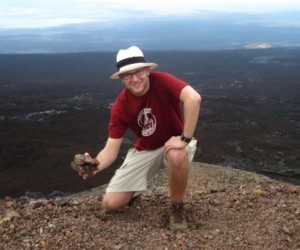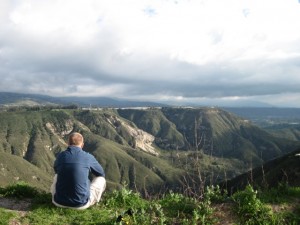
Chris Kelly ’13
Chris Kelly ’13 (Boyertown, Pa.), a double major in geology and international affairs, was one of 24 students who spent three weeks over the January interim studying the evolution of life and land in Ecuador and the Galapagos Islands. The course, taught by geology professors Lawrence Malinconico and David Sunderlin and Provost Wendy Hill, was one of eight faculty-led interim-abroad classes at locations around the globe. Kelly writes about his experience below.
It is surreal to come back to campus and reflect upon what I’ve just experienced. In many ways, the trip was sensory overload. If I had not trekked over and swam through many of the landscapes, I would have hardly believed that they existed.
As a newcomer to the field of geology, I am just starting to appreciate the grandiosity of the field and the opportunities for understanding the world around us that it provides. I have always been a “naturalist,” mesmerized and riveted by the earth around me, but in the past this consisted mainly of ecological knowledge.
This trip represented for me many things, but chiefly the cementation of geology as a new and exciting way of understanding the past. This resonated particularly with one of Prof. Sunderlin’s comments. We were on a boat hopping between islands and as we approached our day stop, he remarked upon the genesis of the place and how he pictured a time-lapse sequence of this volcano being erupted out of the sea and then subsequently being settled by first pioneer species of insects and plants, and then the arrival of Darwin’s finches, all the while being weathered and eroded by the forces of wind, water, and temperature fluctuations.
The interconnectedness is astonishing. I cannot walk over terrain, even now back in Pennsylvania, without painting this portrait of sorts in my mind of the evolution of the landscape and life. Just as history is the key to understanding the present in terms of social studies, geology is a portal to the past in its capacity to shed light unto the topography and structures on which we live and visit today.
 It is one thing to learn these lessons in the classroom. It is quite another in the field. Having knelt at the summit of a volcano, one becomes acutely aware of the subject material. I’ve smelled sulfur and felt the heat being emitted out of the volcanic vents.
It is one thing to learn these lessons in the classroom. It is quite another in the field. Having knelt at the summit of a volcano, one becomes acutely aware of the subject material. I’ve smelled sulfur and felt the heat being emitted out of the volcanic vents.
Standing there on that extraterrestrial moonscape was just primordial. Both there on Sierra Negra volcano and also on the mainland in the Paramo and atop strato-volcanoes soaring almost 20,000 feet into the sky, I was humbled by processes that are greater than oneself. My perspective in the fashion in which I view my surroundings has changed both scientifically and philosophically upon return to Lafayette and I’m thankful to have had the tremendous opportunity.


